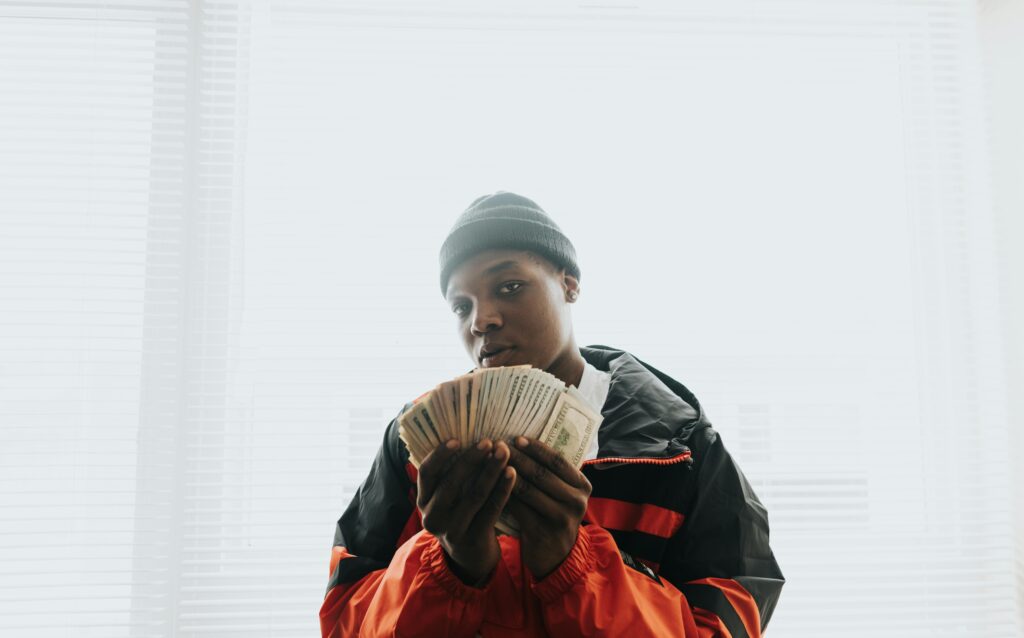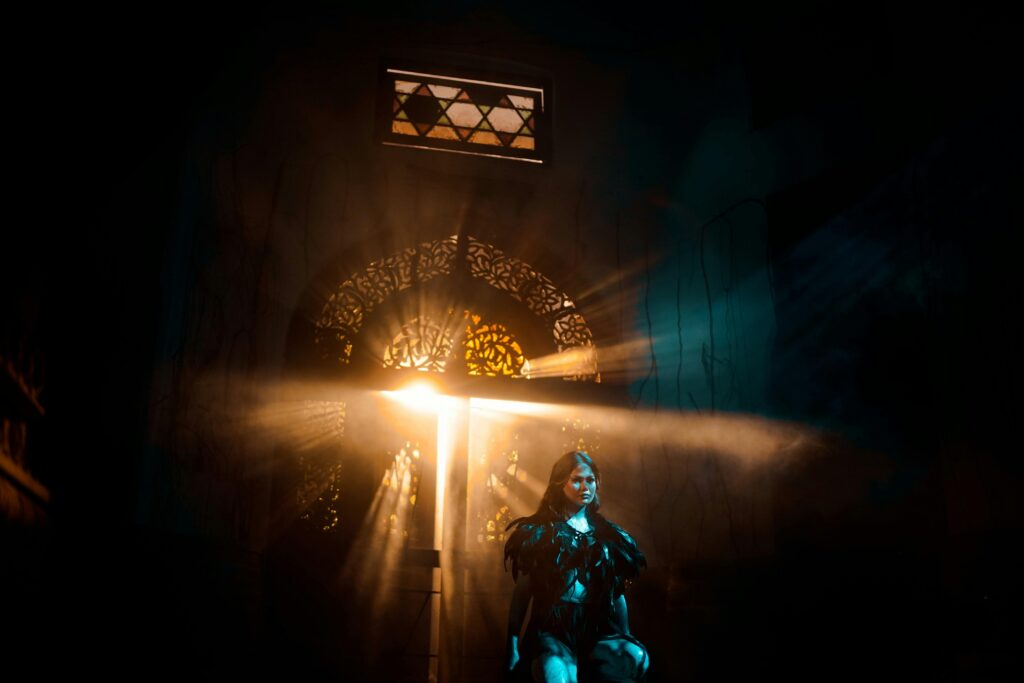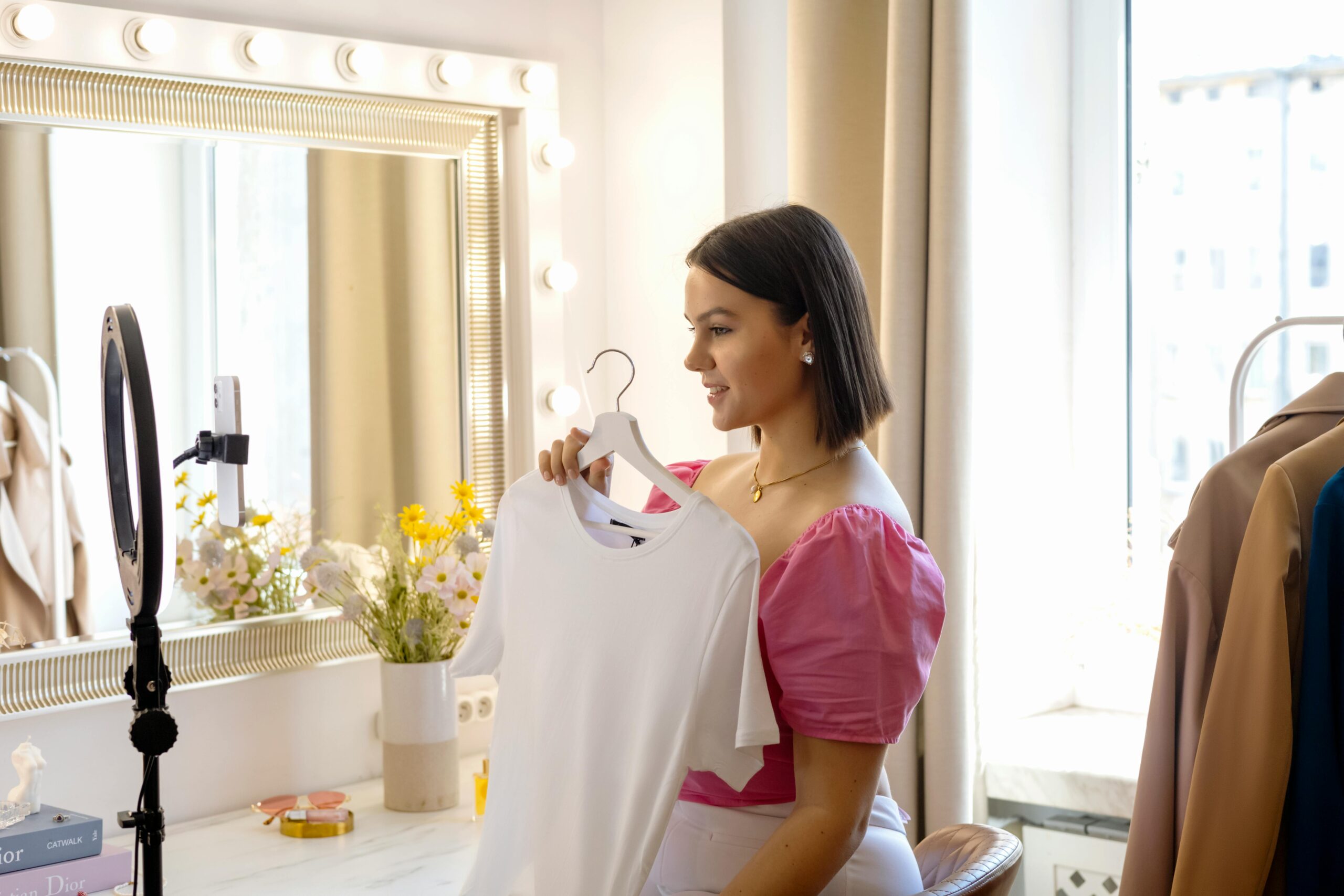Spring: Light layers, pastel colors, and breathable fabrics.
Summer: Lightweight, loose clothing in bright or neutral colors.
Fall: Warm layers, earth tones, and cozy fabrics like wool or cashmere.
Winter: Heavy coats, boots, and darker tones with pops of color.

- Know Your Style
Know Your Likes: Consider the colors, patterns, and silhouettes you like.
Get Ideas: Use Pinterest, Instagram, or fashion magazines to get ideas of what you like.
Try It: Try on different styles to find what works for your body type and personality. - Learn the Fundamentals of Fashion
Wardrobe Staples: Invest in timeless pieces (e.g., a good blazer, white sneakers, classic jeans).
Understand Fit: Clothes that fit well always look more polished.
Know Your Colors: Determine which colors complement your skin tone. - Build a Versatile Wardrobe
Start Small: Buy versatile items that can be mixed and matched.
Accessorize: Add belts, watches, scarves, or jewelry to enhance your look.
Quality Over Quantity: Invest in fewer, high-quality pieces than many fast-fashion items. - Stay Updated
Trend on the Currents: Track the trends that are coming in but just take into your wardrobe whatever suits you.
Fashion Shows & Blogs: Catch runway shows and follow fashion influencers for ideas.
Seasonal Updates: Update your wardrobe season with a few trendy pieces every season. - Understand the Fashion Icons
Look at celebrities or public figures whose style you appreciate. Try to understand how they match things together, and then apply those ideas to your wardrobe. - Shop Smarts
Budget Wisely: Set a budget and do not exceed it.
Thrift & Vintage: Hit the thrift stores for gems you won’t find otherwise
Try Before You Buy: Make sure you wear clothes that fit and don’t chafe - Confidence is Key
Own Your Look: Confidence improves everything.
Embracing Your Individuality: You need to express who you are through your style. - Learn About Fashion Categories
Knowing the various fashions will help you to become the best version of yourself, of course:
Casual: Think T-shirts, jeans, sneakers, and whatever comfortable wear.
Formal: Tailored suits, elegant dresses, or structured pieces.
Streetwear: Hoodies, graphic tees, oversized silhouettes, and sneakers.
Bohemian (Boho): Flowing fabrics, earthy tones, and relaxed vibes.
Athleisure: The merging of athletic and casual wear for everyday wear.
Find these categories to see what speaks to you. - Invest in Statement Pieces
Bold Jackets or Coats: A leather jacket, trench coat, or brightly colored blazer can make an outfit.
Unique Footwear: Shoes with interesting details or vibrant colors can take your look to the next level.
Signature Accessories: That statement watch, bag, or sunglasses can become your signature. - Get to Know Layers and Textures
Layering: Have fun with layers-wear a turtleneck under a blazer, layer a cardigan over a scarf, etc.
Textures: Mix and match materials: denim, leather, silk, and cotton for texture and dimension in your outfits. - Tailor Your Clothes
Even the most expensive piece won’t look good if it does not fit well. Good tailors can adjust the clothes to fit your body, and you will make your wardrobe look custom-made perfectly. - Pay Attention to Grooming
Hairstyle: Your hairstyle should complement your fashion style. Regular trims and styling make a huge difference.
Skincare: Healthy skin makes you look polished and confident.
Personal Hygiene: Clean, fresh-smelling clothes and well-groomed nails enhance your overall look. - Play with Patterns
Begin Subtle: Start incorporating stripes, polka dots, or plaid into your wardrobe.
Mix and Match: Once you are comfortable, try more dramatic combinations (floral shirts with solid pants). - Keep It Organized
Declutter: Sort through your wardrobe and eliminate anything you no longer wear.
Wardrobe Capsules: Create mini wardrobes with a focused few pieces for specific events. - Learn Fashion Etiquette
Dress according to the occasion:
Formal: Suits, gowns, or formal dresses
Casual: Casual yet fashionable
Work: Professional yet refined.- Test Colour
Neutrals first: Black, white, beige, and navy work for everyone.
Pop of Color: It is recommended to add vibrant tones or bold accessories to let your outfits stand out gradually.
Seasonal Colors: Pastels should be integrated into spring, bright tones of summer, earth tones into fall, and deep colors into winter.
- Test Colour
- Embrace Fashion Hacks
Monochromatic Looks: Wearing a single hue always adds to the elegance and taller, put-together look to the wearer.
Third-Piece Rule: Use a third piece for completion (such as a jacket, scarf, or statement accessory).
Proportion: Use fitted with loose, like a tight top and wide-leg pants. - Learn About Sustainability
Sustainable Brands: Be part of eco-friendly fashion brands.
Recycled Material: Be on the lookout for recycled or sustainable fabric-made clothes.
Upcycling: Change old clothes either by alteration or dye. - Seasonal Style
Match your wardrobe to the weather
- Study Fashion History
Understanding the evolution of fashion can inspire your creativity. Learn about iconic designers, trends from different decades, and cultural influences on style. - Network with Fashion Enthusiasts
Join Communities: You can connect through fashion forums, groups, or events.
Collaborate: Engage in styling sessions with your friends or experts to come up with original ideas. - Know Your Proportions and Silhouettes
Balance Out Your Style: Pair oversized with fitted pieces, such as baggy pants with a fitted top.
Know Your Shape: Dress to highlight or balance your body areas:
Hourglass: Highlight the waist using belts or tailored fits.
Pear: Highlight your upper body with bright tops or accessories.
Rectangle: Create curves using peplum tops, belts, or layered looks. - Incorporate High-Low Fashion
Mix high-end and affordable items:
Pair luxury pieces (e.g., designer shoes or a bag) with budget-friendly basics.
This keeps your outfits stylish without breaking the bank.
- Experiment with Cultural Fashion
Incorporate elements from global fashion:
Indian sarees, African prints, Japanese kimonos, or Scandinavian minimalism can add a unique flair to your style.
Make sure you approach cultural fashion with respect and understanding.
- Learn Seasonal Transition Dressing
Use layering to transition between seasons. For example, put a trench coat over a summer dress in the fall.
Invest in transitional pieces such as lightweight cardigans, scarves, or ankle boots. - Find Your “Power Outfit”
Identify a go-to look that makes you feel unstoppable (e.g., a tailored suit, a bold jumpsuit, or a chic monochromatic outfit).
Power outfits give confidence and are good for other important events. - Focus on Details
Small elements can make your outfit superior:
Roll or cuff sleeves as well as pants for a relaxed look.
Replace common buttons on coats or shirts with unique ones.
Pocket square or lapel pin – add some style. - Know Your Fabrics and Materials
Know which fabrics behave in which manners:
Cotton: Can breathe and is versatile so it is great for informal wear.
Wool: Warm and good for winter.
Silk: Luxury and formal, it brings sophistication.
Denim: Tough and timeless, for casual or edgy styles.
Proper fabric care (dry cleaning and ironing) makes clothes last longer. - Create a Signature Style
Develop a personal style feature that people remember you by; it could be the love for hats, statement earrings, or bold colors.
It becomes a personal brand and gives consistency to your style. - Take Advantage of Accessories
Accessories are game changers:
Scarves: Elevate a casual or formal dress.
Belt: Pinch your waist and add polish to a dress or blazer.
Jewelry: Layer necklaces or use mixed metals to get that look of the moment.
Sunglasses: Add class to any outfit.

- Apply Color Theory
Complementary Colors: Use a color directly opposite from another color on the color wheel (blue next to orange).
Analogous Colors: Use neighboring colors on the color wheel for harmony, such as green, blue-green, and blue.
Neutral Palettes: Whites, blacks, and greys can be mixed to achieve a minimalist look. - Re-Create Looks from Media
Movies, TV shows, and music videos are full of ideas:
Look at style icons, such as James Bond or Audrey Hepburn in Breakfast at Tiffany’s.
Find out what the artists in your favorite music are wearing for creative and edgy ideas. - Care for Your Clothes
Well-cared-for clothes always look better:
Laundry Practices: Always follow care labels to avoid damaging the fabric.
Ironing & Steaming: Iron clothes to keep them wrinkle-free.
Storage: Hang clothes on proper hangers and fold sweaters to keep them in shape. - DIY Fashion
Upcycle old clothes into trendy new pieces.
Add patches, embroidery, or fabric paint to customize items.
Tailor thrifted finds for a better fit. - Mind the Proportions
Balance is key in fashion:
Pair oversized items with fitted pieces (e.g., baggy pants with a slim-fit top).
Use high-waisted bottoms to elongate your legs.
Play with cropped jackets or long coats to adjust proportions. - Watch and Learn from Fashion Experts
Follow stylists, designers, and influencers on social media.
Watch YouTube channels dedicated to styling tips and fashion advice.
Read books on fashion history and styling principles. - Dive into Fashion Subcultures
Exploring subcultures can inspire unique styles:
Punk: Leather jackets, studded accessories, and ripped jeans.
Goth: Dark tones, lace, and dramatic silhouettes.
Preppy: Polo shirts, loafers, and blazers.
Vintage: Wear clothing from the ’60s, ’70s, or ’80s.
- Play with Monochrome and Color Blocking
Monochrome: Put on clothes in a single color for a neat and polished look.
Color Blocking: Mix bold, contrasting colors (for example, blue and orange). - Go to Fashion Events
Visit local fashion shows, exhibitions, or pop-up shops.
Network with designers or stylists to know what is in and what is next. - Make a Lookbook
Take pictures of your outfits to determine what works and what does not. This will also help you plan your wardrobe for various occasions. - Be Yourself
Ultimately, fashion is about being yourself. Do not be afraid to break rules or mix styles. Your individuality will always be your best asset. - Invest in Outerwear
Outerwear can define your overall style, especially during colder seasons:
Trench coats, pea coats, and wool overcoats all cut it for casual as well as formal styles.
Statement jackets in leather, bombers, or colorful puffy ones give a rool or modern feel to any outfit.
Layering pieces are great transitional pieces and consist of lightweight cardigans or vests.
- Get Silhouettes in Style
The shape and form that your clothes take will, in many ways, change the style of the garment, drastically:
Oversized Fits: Oversized sweaters, coats, or pants create a relaxed modern look.
Structured Pieces: Blazers, pencil skirts, or tailored trousers are a polished look.
Flowy Fabrics: Maxi dresses, loose tunics, or wide-leg pants evoke a breezy, elegant feel.
- Be Bold in Style
Pushing boundaries is growth:
Try bold prints, like animal or abstract designs.
Experiment with gender-neutral or androgynous fashion.
Wear something out of your comfort zone, such as platform shoes, crop tops, or metallic finishes.
- Create Seasonal Capsules
Build mini wardrobes for each season:
Spring: Light pastel dresses, floral prints, and trench coats.
Summer: Linen shirts, breezy dresses, and sandals.
Fall: Earth-tone sweaters, ankle boots, and scarves.
Winter: Heavy coats, thermal layers, and insulated boots.
- Study Your Body Shape
Knowing your body type can help you pick flattering clothes:
Hourglass: Add fitted or belted styles.
Pear: Use defined tops and A-line dresses for balance.
Rectangle: Curve with peplum tops, ruffles, or flared dresses.
Inverted Triangle: Work volume in bottoms, like wide-leg pants or flowy skirts.
- Dressy Comfort without Sacrificing Style
Comfortable doesn’t have to mean compromising style:
Casual: stretchy fabrics or elastic waistbands.
Ergonomic footwear such as cushioned sneakers or block heels.
Layer lightweight, breathable materials for year-round ease. - Build Confidence in Your Choices
Fashion is at least as much about attitude as it is about the clothes:
Wear something that makes you feel empowered, joyful, or chic.
Stand up straight for confidence in what you wear
Celebrate compliments and wear your personality with pride- don’t hide it - Mix Vintage and Modern
Mix vintage charm and modern relevance
Vintage blouse with modern high-waisted jeans.
Retro sunglasses with a contemporary outfit.
Thrifting is a great way to incorporate some old favorites into your new wardrobe.

- Make Seasonal Trends Work for You
Trends can be great fun, but don’t feel obligated to adopt all of them:
Use the trends that make sense to your style.
Use trendy pieces as an accent, not as a main focus.
Be ageless by using trendy pieces with timeless classics. - Style Inspiration Organisation
Track looks and ideas you like:
Make a Pinterest board of outfit inspiration.
Save Instagram posts or follow hashtags like #OOTD (Outfit of the Day).
Keep a physical scrapbook or journal for ideas and sketches.
- Shop Regional Fashion Stores
Sometimes local stores or designers have unique pieces that you won’t find in mainstream outlets. Support small businesses or artisans to find one-of-a-kind items. - Create a Travel Wardrobe
Plan versatile outfits for trips:
Mix-and-match pieces. Pack wrinkle-resistant fabrics. Include comfortable yet stylish shoes. 53. Master Workwear Create a work wardrobe that’s both professional and fashionable:
Invest in tailored suits or dresses. Stick to neutral tones for versatility. Add personal flair with accessories like scarves, watches, or jewelry. 54. Learn How to Repurpose Clothes Turn old or unused clothes into something fresh:
- Cut old jeans into shorts. Dye faded T-shirts into vibrant hues. Transform long dresses into skirts or tops. 55. Stay Inspired Daily
- Fashion inspiration can be found anywhere:
Observe street style in your city.
Watch documentaries about fashion icons or designers.
Read fashion blogs, books, or magazines regularly.
- Know the Power of Details
The little things can make or break your outfit:
Make sure your clothes are clean and stain-free.
Be sure to match your socks and shoes.
Pay attention to accessories like cufflinks, ties, or hair clips.
- Rotate Your Wardrobe
Don’t get stuck in a fashion rut:
Rearrange your closet every few months to rediscover forgotten pieces.
Challenge yourself to style old items in new ways.
- Wear Confidence as Your Best Accessory
Even the most stylish outfit needs confidence to shine:
Smile often—it’s the ultimate fashion statement.
Walk with purpose and pride.
Be unapologetically yourself in whatever you wear.
